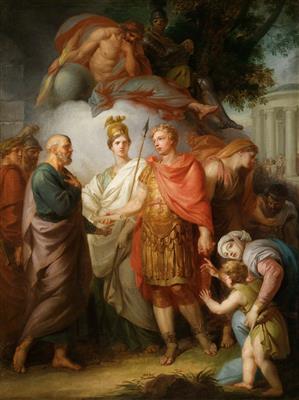Heinrich Friedrich Füger

(Heilbronn 1751–1818 Vienna)
The Apotheosis of Emperor Joseph II as a protector of science and knowledge,
oil on canvas, 98 x 73 cm, framed
Provenance:
Formerly owned by Füger’s student, the engraver Friedrich John, and his descendants, Vienna;
Sale, Dorotheum, Vienna, 16 October 2007, lot 76;
Private collection, Vienna
Literature:
K. Wilczek, Heinrich Friedrich Füger, Seine Gemälde und Zeichnungen (doctoral thesis), Vienna, 1925, p. 61, no. 12;
Y. Del Pozo, Apotheose Kaiser Josefs II., Bozzetto von F. H. Füger (admission paper to the Department of Art History, University of Vienna), Vienna, 1975; R. Keil, Heinrich Friedrich Füger 1751–1818, Vienna, 2009, p. 49 and p. 224, no. 94, fig. 9
In September 1776, Füger was finally able to embark on his long-awaited journey to Rome, having received a scholarship from the Vienna Academy. He was obliged to send drawings,copies of antique works, to Vienna on a regular basis in order to prove the progress of his studies, while he also had to execute a large-scale historical or allegorical painting in oil. He eventually chose an allegorical subject that was to represent Emperor Joseph II as a protector of knowledge and wisdom. The present composition is a bozzetto for this large painting, which is now conserved in the Kunsthistorisches Museum in Vienna (inv. 2476, 332 x 248 cm.) and which is signed and dated: “Füger pinx. Romae 1779”.
The oil sketch differs from the painting in several details and displays a much stronger classicist influence, which Füger mitigated in the final painting. The design is still dominated by a relatively clear arrangement of the individual figures and does without substantial overlaps. In fact, the design of restrained gestures betray the idea of a purified taste adopted from the artist’s teacher, Oeser, by reducing the figures’ actions to the most essential. The compostion also displaysthe influenceof the works of contemporary artists in Rome such as Batoni or Mengs, to whose ideas Füger had sought to adapt himself. Robert Keil (see literature) writes about the present painting: “With its restrained gestures and static composition, the design reflects Oeser’s idea of a purified taste. This implied reducing the narration to what is fundamental, which in turn should become perceptible in the protagonists’ postures and facial expressions”.
Esperto: Dr. Alexander Strasoldo
 Dr. Alexander Strasoldo
Dr. Alexander Strasoldo
+43 1 515 60 403
old.masters@dorotheum.com
21.10.2014 - 18:00
- Stima:
-
EUR 28.000,- a EUR 32.000,-
Heinrich Friedrich Füger
(Heilbronn 1751–1818 Vienna)
The Apotheosis of Emperor Joseph II as a protector of science and knowledge,
oil on canvas, 98 x 73 cm, framed
Provenance:
Formerly owned by Füger’s student, the engraver Friedrich John, and his descendants, Vienna;
Sale, Dorotheum, Vienna, 16 October 2007, lot 76;
Private collection, Vienna
Literature:
K. Wilczek, Heinrich Friedrich Füger, Seine Gemälde und Zeichnungen (doctoral thesis), Vienna, 1925, p. 61, no. 12;
Y. Del Pozo, Apotheose Kaiser Josefs II., Bozzetto von F. H. Füger (admission paper to the Department of Art History, University of Vienna), Vienna, 1975; R. Keil, Heinrich Friedrich Füger 1751–1818, Vienna, 2009, p. 49 and p. 224, no. 94, fig. 9
In September 1776, Füger was finally able to embark on his long-awaited journey to Rome, having received a scholarship from the Vienna Academy. He was obliged to send drawings,copies of antique works, to Vienna on a regular basis in order to prove the progress of his studies, while he also had to execute a large-scale historical or allegorical painting in oil. He eventually chose an allegorical subject that was to represent Emperor Joseph II as a protector of knowledge and wisdom. The present composition is a bozzetto for this large painting, which is now conserved in the Kunsthistorisches Museum in Vienna (inv. 2476, 332 x 248 cm.) and which is signed and dated: “Füger pinx. Romae 1779”.
The oil sketch differs from the painting in several details and displays a much stronger classicist influence, which Füger mitigated in the final painting. The design is still dominated by a relatively clear arrangement of the individual figures and does without substantial overlaps. In fact, the design of restrained gestures betray the idea of a purified taste adopted from the artist’s teacher, Oeser, by reducing the figures’ actions to the most essential. The compostion also displaysthe influenceof the works of contemporary artists in Rome such as Batoni or Mengs, to whose ideas Füger had sought to adapt himself. Robert Keil (see literature) writes about the present painting: “With its restrained gestures and static composition, the design reflects Oeser’s idea of a purified taste. This implied reducing the narration to what is fundamental, which in turn should become perceptible in the protagonists’ postures and facial expressions”.
Esperto: Dr. Alexander Strasoldo
 Dr. Alexander Strasoldo
Dr. Alexander Strasoldo
+43 1 515 60 403
old.masters@dorotheum.com
|
Hotline dell'acquirente
lun-ven: 10.00 - 17.00
old.masters@dorotheum.at +43 1 515 60 403 |
| Asta: | Dipinti antichi |
| Tipo d'asta: | Asta in sala |
| Data: | 21.10.2014 - 18:00 |
| Luogo dell'asta: | Wien | Palais Dorotheum |
| Esposizione: | 11.10. - 21.10.2014 |
